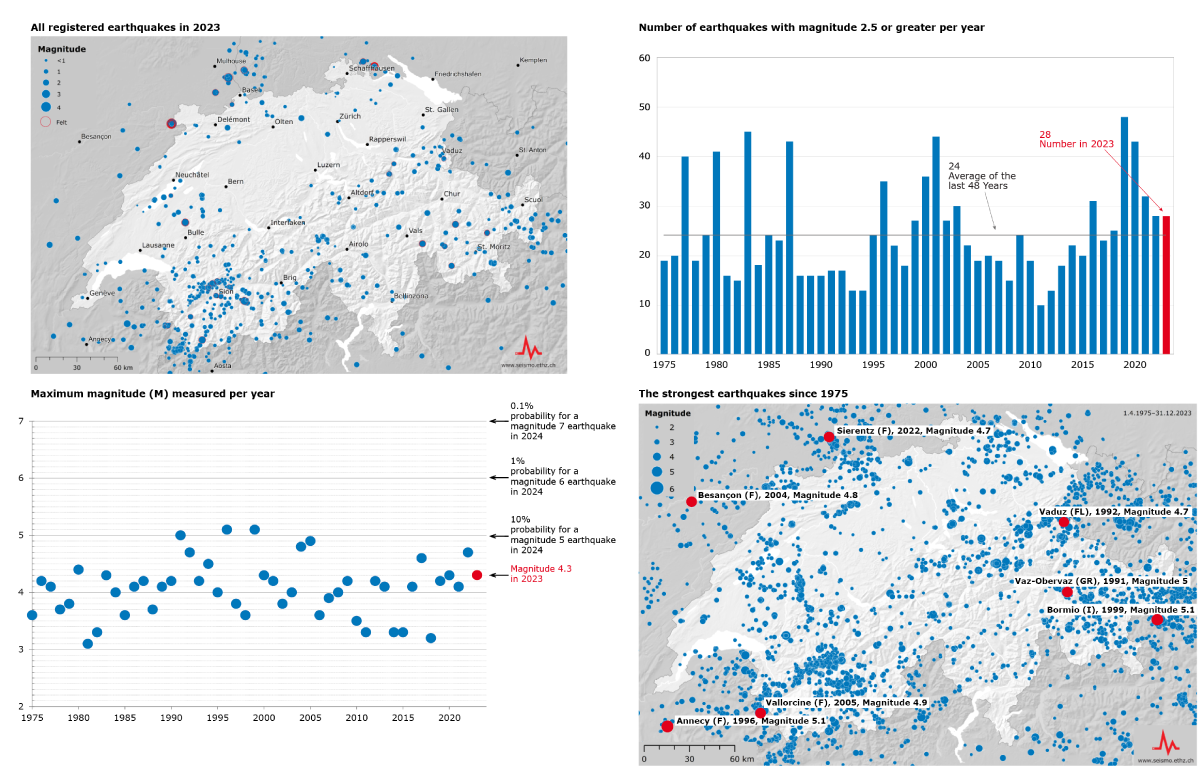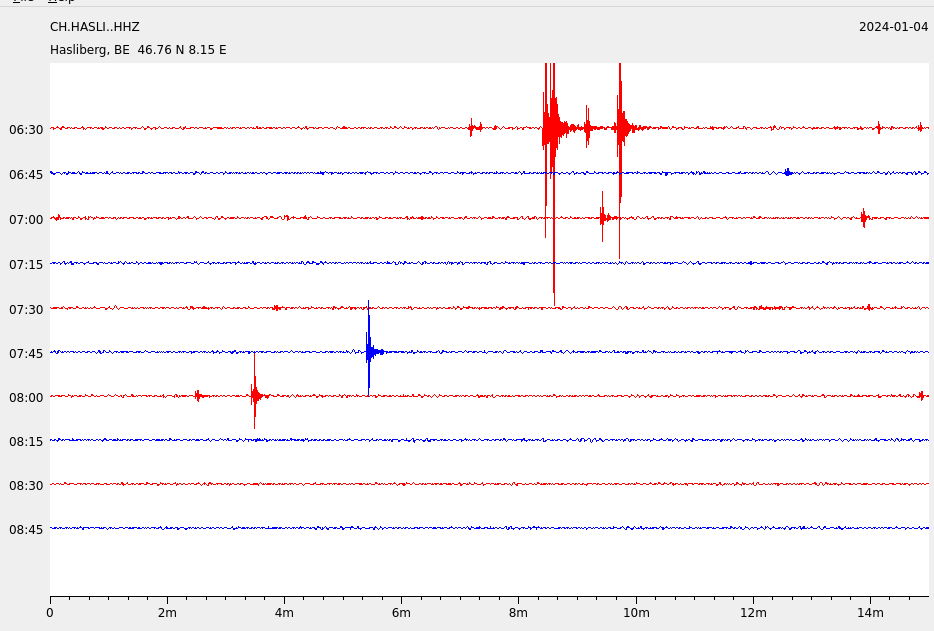News Archive 2024
2024-07-09
How humans can set off seismometers
Seismic stations record any kind of ground motion, and therefore much more than just earthquakes. Our measurements are dominated by ambient seismic noise. These are vibrations caused by distant ocean waves, atmospheric pressure changes, or anthropogenic events such as blasts in quarries, traffic, construction work or explosions. This noise can be used to image the Earth beneath us, or to estimate the extent to which the local subsurface can amplify seismic waves.
Where relevant or necessary, this data can also be used to draw conclusions about events with a seismic footprint. US singer Taylor Swift's concert in Zurich on 9 June was one such event (others occurred on dates when she performed elsewhere). When a lot of people move rhythmically at the same time, this energy is transferred into the ground as harmonic vibrations and can be measured by nearby seismometers. The vibrations caused by the concert audience were visible at eight stations in the seismic network within a 6 kilometre radius of the Letzigrund Stadium. Beyond that, they got lost in other background noise. Previously, other large concerts or football matches have left similar marks on the seismic data.
Read more...How clearly human motion can be made out in the background noise depends on a number of factors. For example, there is the distance from the nearest seismic station. One person jumping immediately next to a seismometer will be enough to bring about visible fluctuations. As the distance from the seismometer increases, a larger number of people moving will be needed to produce this effect. For instance, if Switzerland had won the 2024 European Football Championship, families leaping up from their sofas would not have been reflected in the seismic data, whereas the enthusiasm of fans at large-scale public viewings might have been picked up. The subsurface is also a factor here. If crowds move about rhythmically on a soft subsoil, such as the gravel deposits of the Limmat Valley, the vibrations are stronger than on harder rock, although they are also attenuated more quickly with distance. The ground motion is further amplified when people cause a structure, such as a stand, to vibrate at its resonant frequency. Of course, the opposite effect can also be observed. For instance, the measures taken to combat the spread of COVID-19 led to a worldwide reduction in seismic noise caused by human activity from early to mid-2020 (SED news item).
As to whether Taylor Swift generates more or less enthusiasm than other acts or a football match also resulting in measurable seismic vibrations, this cannot be reliably determined from the seismic data.
2024-07-09
Rapid impact assessments now available
From now on, the Swiss Seismological Service (SED) at ETH Zurich will publish a rapid impact assessment for any earthquake with a magnitude of 3 or more. This will inform emergency services, authorities and the public about the expected human and financial consequences of earthquakes that are felt over a wide area or cause damage, doing so shortly after these quakes occur. The assessments are based on the relevant quake parameters and the earthquake risk model of Switzerland published in 2023.
After a severe earthquake, emergency services must rapidly obtain a picture of the situation in order to deploy their resources as efficiently as possible. Rapid impact assessments contribute to this process, especially in the hours immediately after an earthquake when only limited or incomplete information is available from the affected area. It is also very important to keep the public informed in such a scenario. Although large-scale damage is only anticipated for earthquake magnitudes of around 5 or above, the SED already publishes a rapid impact assessment for smaller quakes with a magnitude of 3 or more. This helps to ensure that the whole process from creation through to application can be enacted and practised on a regular basis. On average, damaging earthquakes occur in Switzerland only every 8 to 15 years.
Read more...The rapid impact assessment values given are automatically generated estimates based on the earthquake risk model of Switzerland. However, the actual extent of the damage may differ considerably from these estimates, and the accuracy of any information is not guaranteed. There may be changes, for example, if the earthquake parameters underlying the impact assessment are updated during the detailed analysis. The decisive factor in the calculations is the modelled impact of the quake on potentially affected buildings. This makes it possible to estimate the approximate number of fatalities and people injured and seeking protection as well as the costs of damage to buildings. Different occupancy patterns depending on the time of day and seasonal occupancy fluctuations are currently not taken into account here, nor are human and financial losses resulting from damage to infrastructure (e.g. bridges, railway lines) or secondary damage (e.g. fire, landslides). In addition, rapid impact assessments of aftershocks disregard the damage that has already occurred and any increased vulnerability of buildings due to previous earthquakes.
As well as a publicly available overview of the expected consequences of the earthquake at national level, authorities and the Earthquake Damage Organization (EDO) will have access to cantonal overviews, showing the anticipated consequences of a quake for each canton and its communes. Access to the cantonal overviews is limited because the uncertainties at this level are even greater than at national level, meaning that the values need to be interpreted with due caution. The SED usually publishes the national overviews on its website (www.seismo.ethz.ch) within an hour of a quake, i.e. as soon as the data can be prepared.
Further information on rapid impact assessments can be found here.
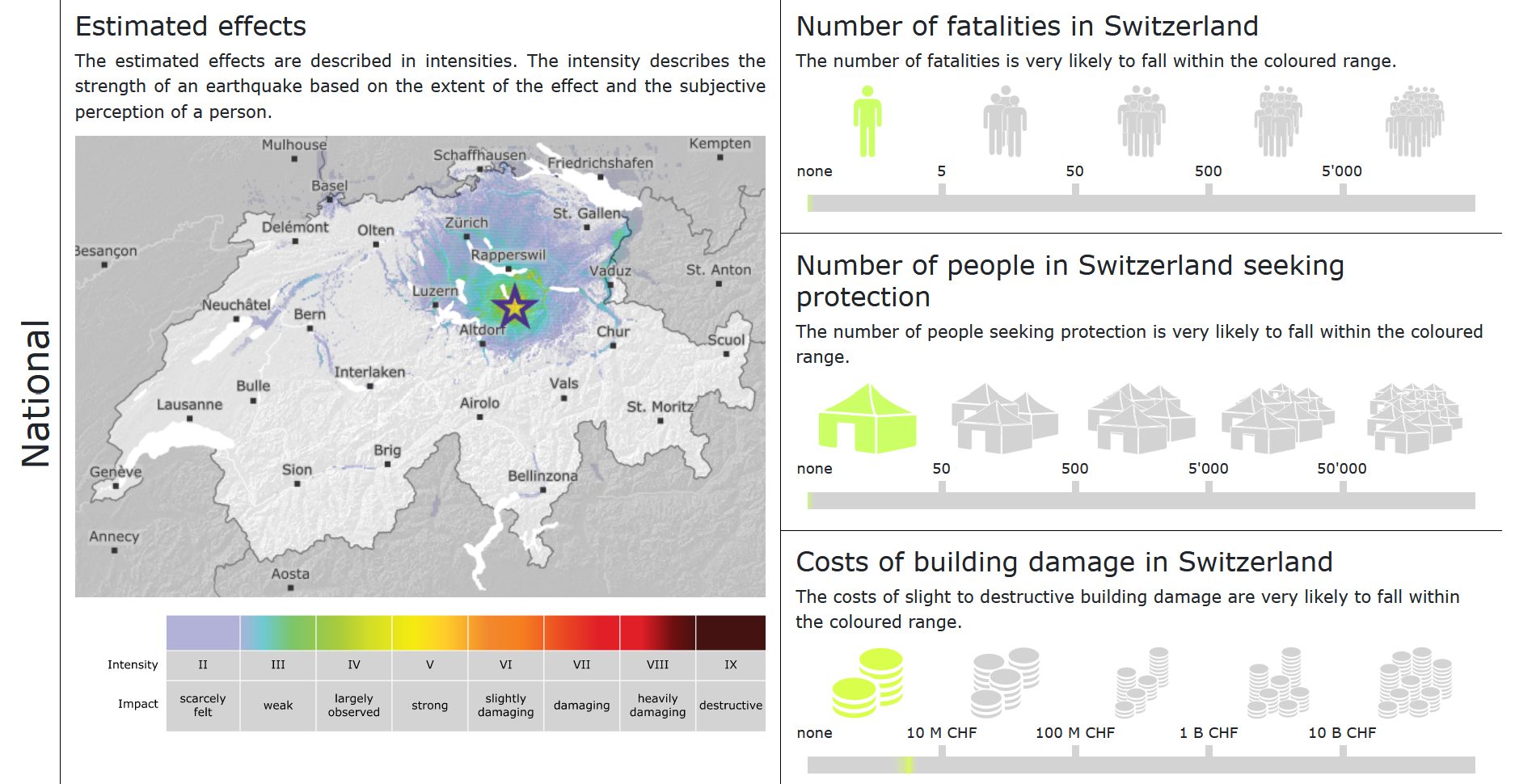
2024-06-27
[Available in DE/FR] Erdbeben bei Laufenburg (AG)
Am Donnerstagmorgen, dem 27. Juni 2024, hat sich um 03:06 Uhr (Ortszeit), 15 km nördlich der Schweizer Grenze in einer ungefähren Tiefe von 8 km ein Erdbeben der Magnitude 4.2 ereignet.
Beim Schweizerischen Erdbebendienst an der ETH Zürich sind bereits in der Nacht über 1'200 Verspürtmeldungen eingegangen. Das Beben war im nördlichen Aargau deutlich spürbar und stark genug, um einen Teil der Bevölkerung zu wecken (Intensität IV). Die meisten Meldungen kamen aus Liestal, Schaffhausen, Möhlin, Pratteln und den umliegenden Gebieten. Vereinzelt wurde das Beben einem Umkreis von über 100 km um das Epizentrum verspürt. Innerhalb weniger Minuten wurden in der unmittelbaren Umgebung bereits 2 Nachbeben der Stärke 1.7 und 1.4 gemessen. Bislang wurden keine Schäden gemeldet.
Read more...Erdbeben sind in dieser Region nicht ungewöhnlich. Das letzte spürbare Beben im Raum nördlich von Laufenburg wurde am 12. März 2018 mit einer Magnitude von 3.1 in 17 km Tiefe registriert, ebenso eines in Zell (20 km vom heutigen Beben entfernt) am 5. Mai 2009 mit einer Magnitude von 4.2 in 12 km Tiefe.
Es kann mit weiteren Nachbeben gerechnet werden. Solche Nachbeben treten üblicherweise nach stärkeren Beben auf, wobei die Häufigkeit und die Stärke dieser Ereignisse mit der Zeit abnimmt. Weitere Beben mit einer ähnlichen oder gar grösseren Magnitude wie das Beben um 3:06 Uhr sind zwar unwahrscheinlich, aber nicht auszuschliessen.
![[Available in DE/FR] Erdbeben bei Laufenburg (AG) [Available in DE/FR] Erdbeben bei Laufenburg (AG)](/export/sites/sedsite/home/.galleries/img_news_2024/Laufenberg2024.png_2063069299.png)
2024-06-04
[Available in DE/FR] Verspürtes Beben im Sihltal (SZ)
Ein Beben der Magnitude 4.4 ereignete sich am Dienstag, 4. Juni 2024, um 2:34 Uhr (Ortszeit) im Sihltal (SZ), rund 12 km südöstlich von Einsiedeln in einer sehr geringen Tiefe von ungefähr einem Kilometer. Weil sich das Beben so nahe der Erdoberfläche ereignet hat, war es im Epizentralgebiet stark zu spüren, jedoch gemessen an seiner Stärke in einem vergleichsweise geringen Umkreis. Dies belegen die ungefähr 130 Verspürtmeldungen, die in der ersten halben Stunde nach dem Beben beim Schweizerischen Erdbebendienst (SED) an der ETH Zürich eingegangen sind und praktisch alle von einer Epizentralentfernung von weniger als 30 km kamen. Auch typisch für solch untiefe Beben ist, dass sie teilweise als Knall und weniger als Bodenerschütterung wahrgenommen werden. Bei einem Erdbeben dieser Stärke können vereinzelt kleinere Gebäudeschäden (z.B. Risse im Verputz) bei den verletzlichsten Gebäuden auftreten.
Read more...Es kann mit Nachbeben gerechnet werden. Solche Nachbeben treten üblicherweise nach stärkeren Beben auf, wobei die Häufigkeit und die Stärke dieser Ereignisse mit der Zeit abnimmt. Weitere Beben mit einer ähnlichen oder gar grösseren Magnitude wie das Beben um 2:34 sind zwar unwahrscheinlich, aber nicht auszuschliessen. Beben mit einer Magnitude von 4 oder mehr treten in der Schweiz im Schnitt alle ein bis zwei Jahre einmal auf. Das letzte Beben mit einer vergleichbaren Stärke (Magnitude 4.4) in dieser Region ereignete sich am 25. Oktober 2020 bei Elm (GL). Das letzte verspürte Beben im Kanton Schwyz ereignete sich am 4. März 2015 östlich der Kantonshauptstadt. Es hatte eine Magnitude von 2.8.
2024-05-28
New: list of mass movements now online
Switzerland's highly sensitive seismic network monitors tectonic movements around the clock. Earthquakes though are not the only cause of tremors. Explosions, sonic booms or mass movements such as landslides, rockfalls or mudslides can also be recognised in the seismic recordings once they reach a certain size. Over the past decades, the Swiss Seismological Service (SED) at ETH Zurich has been collecting many such mass movement events and now also publishes this information online in addition to the recorded data on earthquakes and explosions.
It is Sunday, 30 July 2023 in Bisisthal in the canton of Schwyz. Early in the morning, 150,000 cubic metres of rock came loose from the mountain. This was followed by another mass movement in the late afternoon, during which a mass of rock twice as large came crashing down.
Read more...Video recordings document this impressive event, but fortunately, no one was injured. However, the seismic stations also recorded the tremors caused by the landslide, even at distances well over 100 kilometres. In contrast to earthquakes, seismograms of mass movements are comparatively long-lasting and are characterised by a broad distribution of seismic energy. They also lack the clear, impulsive phase arrivals typical of earthquakes. This makes the exact location of a mass movement very uncertain using only the seismic information; it can deviate several kilometres from the true location. However, the origin time of mass movements can be determined to the second.
Only mass movement events that are clearly visible in the seismic data are listed in the newly published SED database. The list of events is therefore incomplete: smaller or slow-moving mass movements or those that occur in areas with poor coverage of the seismic network are not detected. Furthermore, the identification of mass movements is carried out manually, so new events may only be added days after they occur. Some events are externally confirmed and indicated as ‘confirmed’ in the last column of the list. The magnitude is purely indicative and calculated using the scale defined for local Swiss earthquakes. The list of mass movements dates back to 2009 and will continue to be updated.
More information
2024-05-21
Seismometers in schools record earthquakes
Taiwan is over 9,500 kilometres from Switzerland, much too far for even strong earthquake tremors to be felt here. Nevertheless, the major quake on 3 April 2024, with a magnitude of 7.4, did not go unnoticed: waves from the earthquake were recorded not only by the seismic network of the Swiss Seismological Service (SED) at ETH Zurich but also by 17 Raspberry Shake seismometers installed at Swiss schools. These are small portable devices, each with three high-precision sensors (geophones) and an digitaliser. They were installed at the start of this year as part of the Seismo@School project. The SED is leading the project in close collaboration with the University of Lausanne (UNIL) and the Centre Pédagogique Prévention Séisme (CPPS) in Sion. The aim is to raise pupils' awareness of earthquakes, promote the STEM subjects and strengthen collaboration between educational and scientific institutions.
Read more...Hands-on earthquake research in the classroom
Since they were installed, the seismometers at cantonal schools and high schools have been continuously recording the earth's movements. That also includes the tremors from local quakes such as the one on 27 February near Saignelégier (canton of Jura) with a magnitude of 3.4. Students can access the data recorded on their own devices as well as over 2,000 Raspberry Shake seismometers installed worldwide in real time via the Raspberry Shake website. The data is presented in an easy-to-understand way, making it easy to pinpoint the epicentre of an earthquake, for example, as part of a lesson. This allows pupils to gain practical insights into the world of earthquake research and deepen their understanding of various seismological concepts.
The Seismo@School programme
The Seismo@School initiative has its origins in a programme launched by the University of Lausanne and HES-SO Valais-Wallis in recent years, in which 22 schools in the cantons of Valais and Vaud are involved. Thanks to a two-year AGORA project funded by the Swiss National Science Foundation (SNSF) entitled "Increasing earthquake awareness in Switzerland", the SED has now been able to extend this programme to the whole of Switzerland.
The long-term vision of the project is a Switzerland-wide Seismo@School programme that includes multilingual teaching materials, regular activities for teachers and international partnerships. This initiative is a major step in promoting earthquake preparedness and knowledge among young people, which will ultimately help ensure that society is better able to cope with earthquakes in the future.
Resources for teachers
In the coming months, the Seismo@School team will be developing, and making freely available, school materials covering specific seismology topics: earthquake hazard and risk, induced seismicity, misinformation and media literacy, and earthquake measurement and localisation. From spring semester 2025, geography teachers will also be offered an annual training day on the new teaching materials. There is also a digital learning hub "CoP Geography" on Microsoft Teams, where teachers can network and share helpful materials. Interested teachers can email the Seismo@School project team at: seismo_at_school[at]sed.ethz.ch.
For additional information
Project description
CPPS project web page: www.cpps-vs.ch/seismo-at-school
2024-05-14
Seismic monitoring of the geothermal project in Haute-Sorne (canton of Jura)
Drilling work ahead of the planned deep geothermal project in Haute-Sorne (canton of Jura) will begin in the next few days. The Swiss Seismological Service (SED) at ETH Zurich has consolidated its local measuring system to provide independent baseline seismic monitoring on behalf of the Canton of Jura, thus contributing to a better understanding of local, natural seismicity even before the project gets under way.
Read more...Starting with the exploration phase (installation of the drilling site, sinking of the borehole, test stimulations), baseline monitoring will help to detect any earthquakes near the project site and make it possible to distinguish between natural earthquakes and those caused by the project. The SED will publish the recorded data in real time at this page, providing the Canton, the public, the media and also the project operator with up-to-date information. In addition, the SED will alert the Canton and the operator immediately in the event of earthquakes near the project site.
This baseline monitoring will be of most use in the geothermal project's exploration and stimulation phase (not yet authorized). In the enhanced geothermal system (EGS) solution that will be rolled out in Haute-Sorne, the permeability of existing crack networks in the geological underground will be increased by injecting highly pressurised water to trigger a large number of small earthquakes. While EGS projects are already contributing to heat and energy generation in some places, they have also triggered felt earthquakes in others. In fact, there was one case where it has been suggested that these earthquakes were strong enough to cause substantial damage (see news article on the earthquake in Pohang, South Korea).
In Haute-Sorne, the operater Geo-Energie Jura wants to prevent felt or even damaging earthquakes from occurring with a comprehensive risk analysis, continuously updated models based on newly acquired data and its patented, multi-stage stimulation method. It plans, as part of this process, to stimulate only a limited volume of rock at a time in a number of separate stimulation phases and to gradually create a geothermal reservoir of the appropriate size. This procedure differs from the one-step, mass stimulation strategy adopted, for example, for the EGS projects in Basel in 2006 and Pohang in 2017. The multi-stage stimulation solution has already been successfully tested on a smaller scale in ETH Zurich's BedrettoLab. While there is some risk of felt earthquakes during the Haute-Sorne project's subsequent construction phase (hydraulic stimulation), these are very unlikely to occur during the drilling phase that is about to start. According to the operator, the first test stimulation is not planned to take place until winter 2024/2025.
The baseline monitoring provided by the SED is regulated by an agreement with the Canton of Jura and funded by the Swiss Federal Office of Energy-financed GEOBEST2020+ project. Alongside this baseline monitoring, Geo-Energie Jura operates its own stations to locate even smaller earthquakes, particularly during the stimulation phase, and so monitor the development of the geothermal reservoir. Although this phase is planned, it has not yet been authorized.
Further information on the seismic monitoring of the Haute-Sorne geothermal project can be found on the following pages:
2024-05-09
[Available in DE/FR] Erdbeben bei Arolla (VS)
Am Donnerstag, dem 9. Mai 2024 hat sich um 23:25 Uhr (Lokalzeit) etwa 10km westlich von Arolla (VS), in einer Tiefe von ungefähr 4-5 km ein Erdbeben der Magnitude 3.7 ereignet.
Die Erschütterungen waren in den Walliser Südtälern sowie auf den weichen Sedimentböden im Rhonetal vom Chablais bis nach Brig gut zu spüren. Kurz nach dem Beben sind beim Schweizerischen Erdbebendienst an der ETH in Zürich bereits etwa 500 Meldungen aus der Bevölkerung eingegangen. Bei einem Erdbeben dieser Stärke und in dieser Tiefe sind in der Regel keine Schäden zu erwarten.
Read more...Das letzte, etwas grössere Ereignis in dieser Region, ereignete sich im Oktober 2021 mit einer Magnitude von 4.1 etwa 5 km südlich von Arolla (VS). Der Erdbebenherd lag damals in etwas geringerer Tiefe, verglichen mit dem heutigen Beben. Aufgrund der geringeren Tiefe wären kleinere Schäden nahe dem Epizentrum vereinzelt möglich gewesen. Allerdings ist die Region sehr dünn besiedelt und es wurden dem Schweizerischen Erdbebendienst keine Schäden gemeldet.
2024-05-06
[Available in DE/FR] Erdbeben bei Fribourg
Am Montag, den 6. Mai 2024 hat sich um 13:39 Uhr (Lokalzeit) südöstlich von Fribourg, in einer Tiefe von ungefähr 4 km ein Erdbeben der Magnitude 2.8 ereignet.
Die Erschütterungen waren vorwiegend in Fribourg und in den Gemeinden des Sense-Bezirks St. Ursen, Giffers und Tentlingen deutlich zu spüren. In der ersten Stunde nach dem Beben sind beim Schweizerischen Erdbebendienst an der ETH Zürich über 60 Meldungen aus der Bevölkerung eingegangen. Bei einem Erdbeben dieser Stärke sind keine Schäden zu erwarten.
Read more...Das Beben steht wahrscheinlich im Zusammenhang mit der Fribourger Verwerfungszone, welche überwiegend in Nord-Süd-Richtung verläuft und etwa 20-30 km lang ist. Das letzte spürbare Erdbeben an dieser Verwerfungszone wurde am 29. Dezember 2018 mit einer Magnitude von 2.9 nordwestlich von Tafers aufgezeichnet.
![[Available in DE/FR] Erdbeben bei Fribourg [Available in DE/FR] Erdbeben bei Fribourg](/export/sites/sedsite/home/.galleries/img_news_2024/Fribourg_quake.png_2063069299.png)
2024-04-22
[Available in DE/FR] Weiträumig verspürtes Erdbeben am Neuenburgersee
Am Montag, dem 22. April 2024 hat sich um 3:35 Uhr (Ortszeit) bei Concise (VD), am Ufer des Neuenburgersees, in einer ungefähren Tiefe von 2 km ein Erdbeben der Magnitude 3.8 ereignet.
Die Erschütterungen des Bebens waren im Epizentralgebiet bis nach Lausanne und Bern deutlich zu spüren. In der übrigen Schweiz waren die Erschütterungen in der Regel nicht stark genug, um die Bevölkerung aufzuwecken. Insgesamt sind innerhalb der ersten halben Stunde nach dem Erdbeben beim Schweizerischen Erdbebendienst an der ETH Zürich über 200 Verspürtmeldungen eingegangen, Schäden wurden bisher nicht gemeldet, sind aber bei einem Erdbeben der Stärke 3.8 auch nicht zu erwarten.
In diesem Gebiet, unter dem Neuenburgersee und auch am nordwestlichen Ufer, ist es in den letzten Jahren immer wieder zu schwachen Beben gekommen. Das Beben von Montag war das stärkste bisher.
![[Available in DE/FR] Weiträumig verspürtes Erdbeben am Neuenburgersee [Available in DE/FR] Weiträumig verspürtes Erdbeben am Neuenburgersee](/export/sites/sedsite/home/.galleries/img_news_2024/20240422_Concise_DE.png_2063069299.png)
2024-03-25
Information about earthquakes in plain language
Lots of people find it easier to understand texts in plain language.
So, this website now offers
information about earthquakes in plain language.
These topics are available in plain language:
- Information about earthquakes
- A list of the last earthquakes in Switzerland
- Recommendations: what to do during an earthquake
Everyone should be able to access important topics.
For example, one important topic is:
natural dangers.
Earthquakes are a natural danger.
Earthquakes can be dangerous.
This is why you need to know about earthquakes.
How to access the topics in plain language:
Click on the ‘plain language’ symbol.
This is located at the top.
Or click on this link:
Information about earthquakes in plain language.
Why do we need information about earthquakes in plain language?
People with learning difficulties, cognitive impairments, a different native language, or illnesses such as dementia often find it difficult to understand texts. Plain language is a tool that enables these people to inform themselves independently and act accordingly. This is particularly relevant for topics such as earthquakes, which affect the entire population. Together with the Pro Infirmis Office for Plain Language (Büro für Leichte Sprache in German), the Swiss Seismological Service has translated information about earthquakes in Switzerland and recommended behaviour into plain language and tested it with the target group. The texts are available in German, English, French, and Italian.
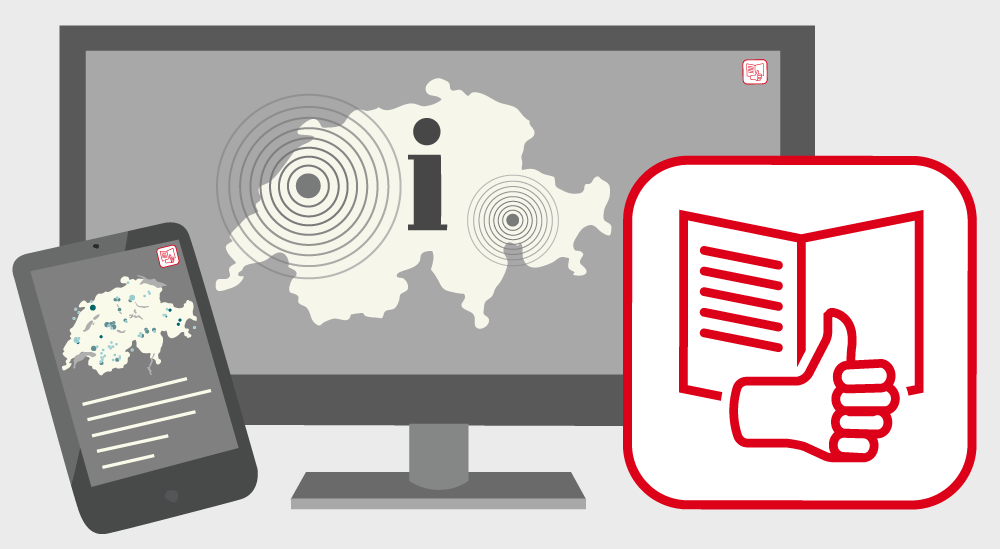
2024-03-18
[Available in DE/IT] Erdbeben im Val Bavona (TI)
Am Montag, den 18. März, hat sich am späten Nachmittag um 16:52 Uhr (Lokalzeit) ein Erdbeben der Magnitude 3.4 mit einer Tiefe von etwa 7 km im Val Bavona ereignet. Das Beben wurde in einem Umkreis von bis zu 50 km, in Leventina, Maggia- und Verzascatal, vereinzelt auch bis ins Wallis, leicht verspürt. Bei einem Beben dieser Magnitude sind im Allgemeinen keine Schäden zu erwarten.
Kleinere Beben sind in dieser Region keine Seltenheit, dieses Beben ist das bisher stärkste aufgezeichnete in der näheren Umgebung des Bavona-Tals, gefolgt von vier Beben mit Magnituden von 2.5 bis 2.8, die sich zwischen 2008 und 2020 ereignet haben.
2024-02-27
[Available in DE] Spürbares Erdbeben bei Porrentruy (JU)
In der Nacht von Montag auf Dienstag, den 27. Februar hat sich um 02:21 Uhr (Lokalzeit) unweit der französisch-schweizerischen Grenze zwischen Saignelégier und Porrentruy in der Haute-Ajoie im Kanton Jura ein Erdbeben der Magnitude 3.4 in einer Tiefe von etwa 5 km ereignet. Das Beben wurde in der näheren Umgebung deutlich verspürt, trotz der nächtlichen Stunde gingen etwa 20 Verspürtmeldungen beim Schweizerischen Erdbebendienst ein. An Orten nordöstlich des Bebens wurden die Erschütterungen zum Teil in grösserer Distanz verspürt. Bei einem Erdbeben dieser Stärke sind normalerweise keine Schäden zu erwarten.
In der Haute-Ajoie wurden seit Dezember 2021 vermehrt Beben gemessen. Das aktuelle Beben ist dabei schwächer als mehrere der vorangegangenen Beben vom Dezember 2021 (Magnitude 4.1), März 2023 (Magnitude 4.3) und Mai 2023 (Magnitude 3.8), die ebenfalls verspürt wurden.
2024-02-22
[Available in DE] Feuerwehren des Kantons Zürich vertiefen den Spezialfall Erdbeben
Nach einem grösseren Erdbeben wären es vielerorts die Feuerwehren, die als erste Hilfe leisten. Im Rahmen einer regulären Weiterbildung der Feuerwehren des Kantons Zürich, setzten sich diejenigen mit dem Spezialfall Erdbeben auseinander, welche die Einsätze leiten und Mitglieder der Feuerwehren ausbilden. Angeleitet durch Fachpersonen des Erdbebendienstes spielten sie mögliche Auswirkungen und Herausforderungen eines grossen Erdbebens durch. Ein Erdbeben der Magnitude 6 bei Winterthur diente dabei aus Ausgangslage. Das zu erwartende Schadensgebiets wäre weiträumig und würde insbesondere die Kantone Zürich, Thurgau, St. Gallen und Aargau betreffen. Die Erschütterungen des Bebens wären in der ganzen Schweiz zu spüren. Ein solches Ereignis würde die Feuerwehren nicht nur in ihrem Kerngebiet der Brandbekämpfung fordern, sondern auch in der Bergung von Personen. Die Schulung zielte darauf ab, das Bewusstsein für die Auswirkungen von Erdbeben zu schärfen und sich mit den vorhandenen Grundlagen vertraut zu machen, welche die Ereignisbewältigung unterstützen können.
![[Available in DE] Feuerwehren des Kantons Zürich vertiefen den Spezialfall Erdbeben [Available in DE] Feuerwehren des Kantons Zürich vertiefen den Spezialfall Erdbeben](/export/sites/sedsite/home/.galleries/img_news_2024/Schulungen-Feuerwehren-des-Kantons-Zuerich.png_2063069299.png)
2024-02-07
Earthquakes in Switzerland in 2023
The Swiss Seismological Service (SED) at ETH Zurich recorded around 1,500 earthquakes in Switzerland and neighbouring regions last year. This is the second highest number after 2019. Most of the quakes recorded in 2023 (Animation) were associated with earthquake sequences close to the Swiss border, near Singen (Germany), Sierentz (France) and Courmayeur (Italy). Last year's strongest earthquake, with a magnitude of 4.3, was also part of a sequence. This occurred in Haute-Ajoie near Réclère (canton of Jura). There were other locally felt earthquakes near Rossens (canton of Fribourg), Tiefencastel (canton of Grisons), Vaduz (Liechtenstein) and Mollis (canton of Glarus).
Read more...The past year was marked seismically by several earthquake sequences in which numerous localised earthquakes occurred over several days or even months. Such sequences accounted for the three strongest quakes of 2023. The most powerful was a 4.3-magnitude earthquake in Haute-Ajoie near Réclère (canton of Jura) on 22 March. This was also the strongest earthquake recorded in the region in the last 100 years. The tremors from the quake were clearly felt in the Jura and throughout the western Swiss Plateau. There were also isolated reports from Lausanne, Bern, Lucerne and Zurich. The second largest quake of 2023, with a magnitude of 3.8, also occurred as part of this sequence (on 29 May). Previously, this region was hit by a 4.1-magnitude earthquake at Christmas 2021, followed by several aftershocks.
The third largest earthquake last year took place outside Switzerland, near Sierentz in Alsace (France), and was felt widely as far as the Basel region and western Aargau. The earthquake had a magnitude of 3.6 and was related to the magnitude-4.7 quake that occurred there in September 2022. These quakes are located in the seismically active Upper Rhine Graben, which extends from the Vosges to the Black Forest. A sequence in the Hegau-Bodensee Graben (also known as the Hegau-Lake Constance Graben) near Singen (Germany) caused further smaller but still noticeable earthquakes in Switzerland. A total of ten quakes of magnitude 2.5 or above have occurred there since June 2023. The strongest earthquakes in this sequence so far took place on 27 June (magnitude 3.1), 29 June (magnitude 3.2) and 25 August (magnitude 3.4). All three were felt sporadically in Switzerland, particularly in the Schaffhausen region.
Several earthquakes felt locally despite small magnitude
Most of the approximately 1,500 earthquakes recorded were too weak to be felt by the population. Twenty-eight had a magnitude of 2.5 or greater, the same number as in 2022 and slightly more than the long-term average. Above this magnitude, earthquakes are usually felt close to the epicentre, as was the case with the quakes in March near Tiefencastel (magnitude 2.6) and Rossens (magnitudes 2.7 and 3.0).
Last year also saw a few earthquakes that could be clearly felt despite their smaller magnitude. This is usually due to a combination of shallow depth, local subsurface amplification effects and other topographic influences, as well as the timing of the earthquake. On the morning of 31 May, shortly before 6 a.m., over 50 people near Vaduz (Liechtenstein) felt slight tremors caused by a magnitude-1.8 earthquake. The quake on 14 December, which happened shortly after midnight near Mollis (canton of Glarus), was even smaller at magnitude 1.6. Because its hypocentre was very close to the surface, just a few hundred metres down, it was powerful enough to wake several people in Mollis and Näfels.
Earthquake impacts in Switzerland systematically determined for the first time
Although several thousand people notice earthquake tremors every year, major damaging earthquakes in Switzerland are becoming a distant memory. However, the earthquake risk model of Switzerland, published for the first time in 2023, shows that the impact of earthquakes on buildings and the associated financial and human losses can be very high. Urban areas in particular are at high risk from earthquakes due to their population density and number of buildings. The SED developed the earthquake risk model at the request of the Federal Council, together with the Federal Office for the Environment (FOEN), the Federal Office for Civil Protection (FOCP), EPFL and other partners from industry. It provides a valuable tool enabling the public, authorities and businesses to prepare for earthquakes and to better cope with the next damaging quake.
2024-01-18
[Available in DE] Small earthquakes between Arosa and Lenzerheide
Am Donnerstag, 18. Januar 2024 um 15:10 Uhr (Lokalzeit) hat sich beim Aroser Rothorn (GR) ein Erdbeben mit einer Stärke von 3.0 in einer Tiefe von etwa 6.4 km ereignet. Innerhalb der ersten Stunde nach dem Erdbeben sind beim Schweizerischen Erdbebendienst (SED) an der ETH Zürich ca. 50 Verspürtmeldungen eingegangen. Die Berichte über Erschütterungen stammen überwiegend aus dem Gebiet um Arosa, Lenzerheide, Valbella, Chur und Davos. Bei einem Erdbeben dieser Stärke ist in der Regel nicht mit Schäden zu rechnen.
Schon am Vormittag gab es um 10:03 Uhr (Lokalzeit) ein Beben der Stärke 2.5 ungefähr am selben Ort, das in der Nähe vereinzelt verspürt wurde. Die Beben ereigneten sich ungefähr je 15 Kilometer südlich von Chur und südwestlich von Davos.
Read more...Das letzte spürbare Beben in der Region ereignete sich am 2. Januar 2012 mit einer Magnitude von 3.5 in der Nähe von Filisur (GR). Davor ereignete sich am 21. Januar 2008 bei Bonaduz (GR) ein Beben mit einer höheren Magnitude von 4.1, gefolgt von jeweils einigen kleineren Nachbeben.
![[Available in DE] Small earthquakes between Arosa and Lenzerheide [Available in DE] Small earthquakes between Arosa and Lenzerheide](/export/sites/sedsite/home/.galleries/img_news_2024/Kleine-Erdbeben-zwischen-Arosa-und-Lenzerheide.png_2063069299.png)
2024-01-04
Series of small earthquakes near Sörenberg (LU)
In the morning of January 4, 2024, starting from 7:37 h (local time), a sequence of more than a dozen earthquakes with magnitudes between 1.5 and 3 was registered near Sörenberg (LU). The strongest events with magnitudes of 2.8, 3.0 and 2.9 happened within one minute and were partly felt by the population up to 15 km from the epicenter. Damage is not expected for such small events.
Since the start of modern seismic monitoring in Switzerland some 40 years ago, hardly any earthquakes were observed in that region. The future development of the sequence is not really predictable. However, one can expect the activity to continue within the next hours and days.
Read more...Such series with many seismic events of comparable magnitude and location are quite common in Switzerland. Currently, other sequences are ongoing near Réclère (Ajoie, JU), above Sion (VS) and between Courmayeur (I) and the Swiss border.
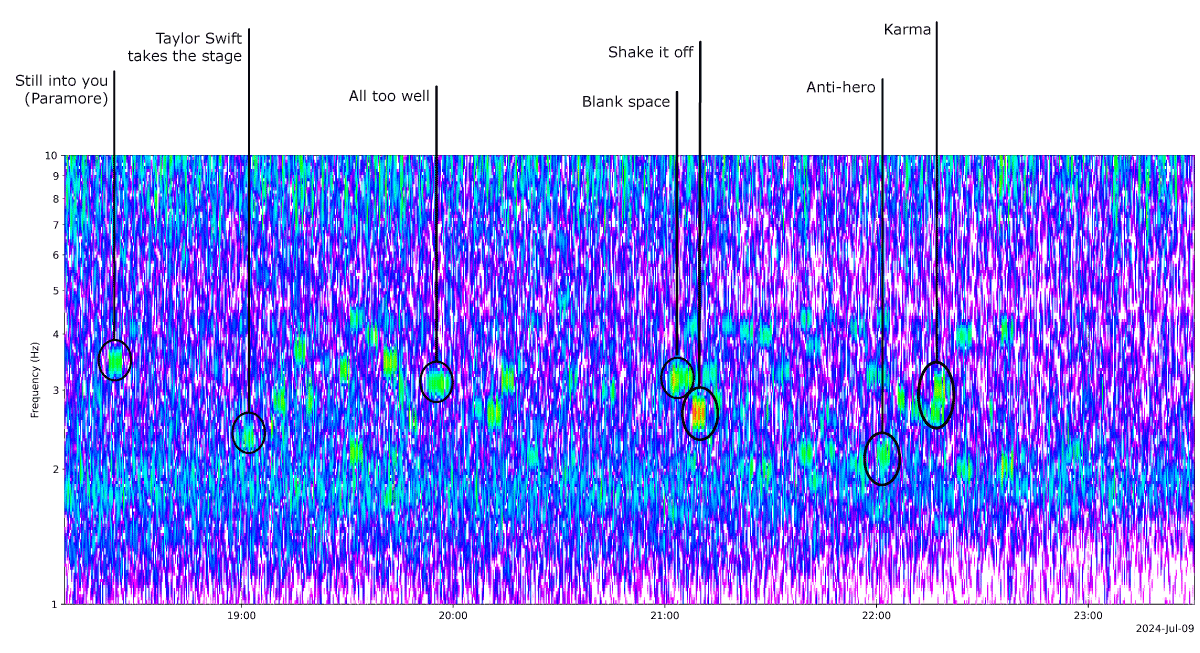
![[Available in DE/FR] Verspürtes Beben im Sihltal (SZ) [Available in DE/FR] Verspürtes Beben im Sihltal (SZ)](/export/sites/sedsite/home/.galleries/img_news_2024/20240604_Studen_image_FR.png_2063069299.png)


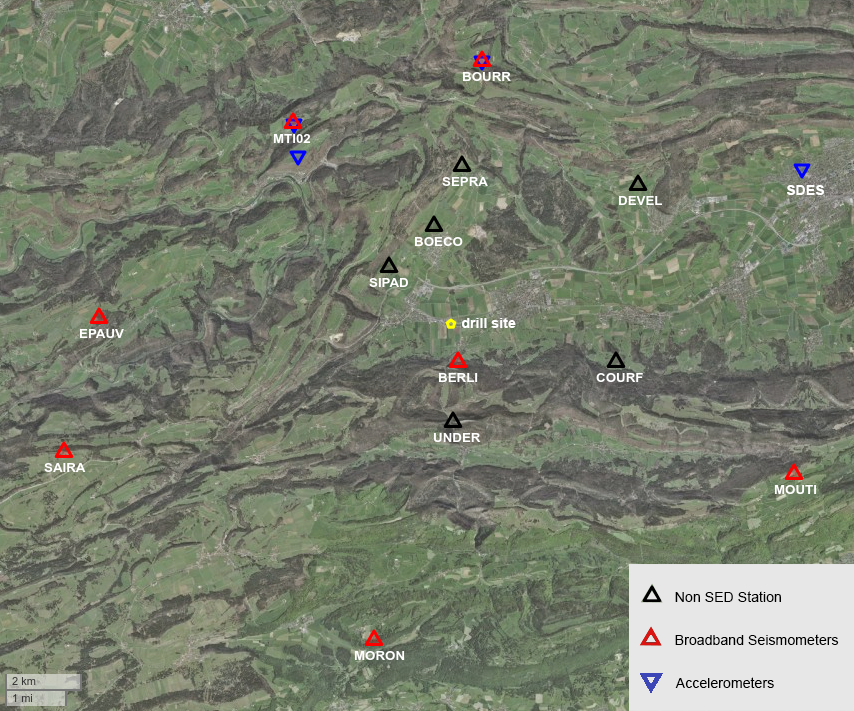
![[Available in DE/FR] Erdbeben bei Arolla (VS) [Available in DE/FR] Erdbeben bei Arolla (VS)](/export/sites/sedsite/home/.galleries/img_news_2024/DE_ArollaVS.png_2063069299.png)
![[Available in DE/IT] Erdbeben im Val Bavona (TI)
© SED [Available in DE/IT] Erdbeben im Val Bavona (TI)](/export/sites/sedsite/home/.galleries/img_news_2023/valbavona.png_2063069299.png)
![[Available in DE] Spürbares Erdbeben bei Porrentruy (JU) [Available in DE] Spürbares Erdbeben bei Porrentruy (JU)](/export/sites/sedsite/home/.galleries/img_news_2024/2024_02_27_Porrentruy_JU.png_2063069299.png)
